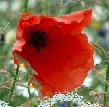|
Events and Places to Visit
Information
of likely interest to website visitors is very
welcome here. Simply
contact us
with details.
2025
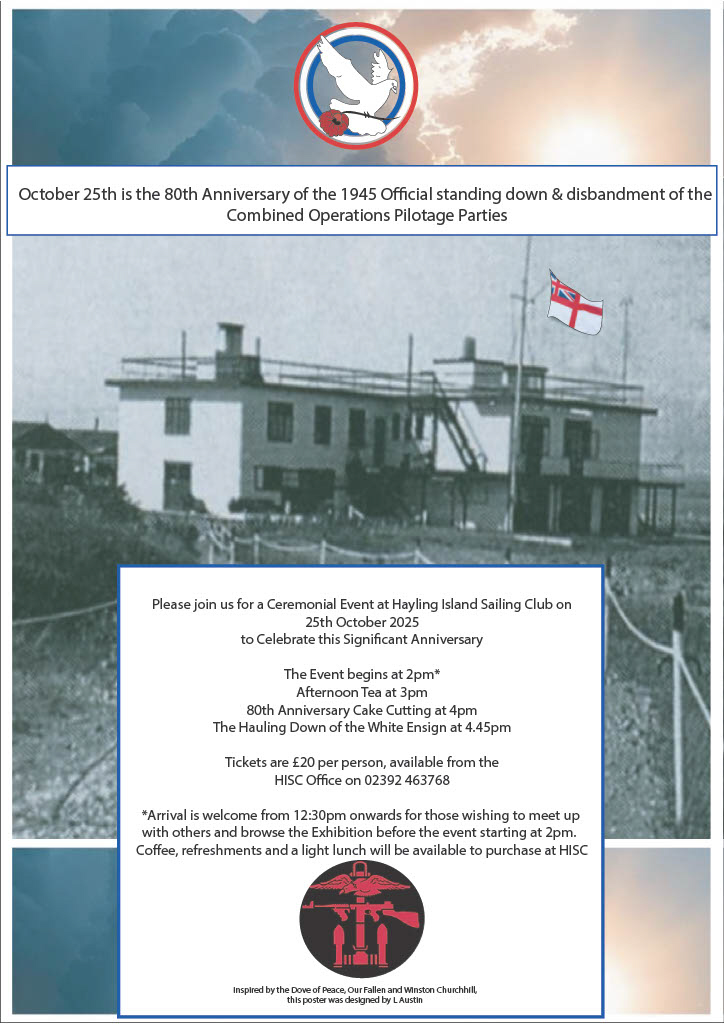
Spring Summer 2025 at the British
Normandy Memorial
The British Normandy
Memorial will host a series of free events and activity through the
Spring and Summer. They look forward to welcoming new and returning
visitors alike in the coming weeks and months to reflect and remember in
this 80th anniversary year of Victory in Europe Day. Full details on the
British Normandy Memorial website - link below.
https://www.britishnormandymemorial.org/news-story/spring-summer-2025-at-the-british-normandy-memorial/
2024
80th ANNIVERSARY
YEAR OF D-DAY
RAF
UXBRIDGE AND ITS COMMAND AND CONTROL BUNKER
4 DAYS OF COMMEMORATIVE
EVENTS
RAF Uxbridge and its
Bunker were crucial to the fighter support over the Channel and the
beaches for Operation Overlord, the D-Day invasion. Although the Bunker
is remembered for its role in the Battle of Britain, it was from here
that the RAF 2nd Tactical Air Force and the USAAF 9th
Air Force were controlled and the adjacent Hillingdon House was the
headquarters of the whole air effort. This year we will be hosting 4
days of events to commemorate this amazing operation.
https://battleofbritainbunker.co.uk/d-day80/
COMBINED
OPERATIONS PILOTAGE PARTIES (COPP)
Hayling Island Sailing Club (HISC) -
Commemorative Event for COPP Families
As we approach the 80th anniversary of D-Day, the message below from the
Hayling Island Sailing Club (HISC), provides us all with a reason to
reflect on the hazardous, clandestine and vital work of a select band of
men under the very noses of enemy patrols on potential landing beaches
in many parts of the world.
https://www.combinedops.com/COPPs.htm
For those of us with family connections to the COPPs, there's also this
special invitation to a unique commemorative event.
D o
you have any family connections with our COPPist Heroes? If so, why not
walk in their footsteps at their wartime home by joining us in a unique
commemorative event, and sharing your stories with other COPP families.
See the flyer opposite for more information, call HISC on 02392 463768
or contact me on 07507 162395 or by email at leonieaustin@outlook.com
You’re sure of a very warm welcome. o
you have any family connections with our COPPist Heroes? If so, why not
walk in their footsteps at their wartime home by joining us in a unique
commemorative event, and sharing your stories with other COPP families.
See the flyer opposite for more information, call HISC on 02392 463768
or contact me on 07507 162395 or by email at leonieaustin@outlook.com
You’re sure of a very warm welcome.
Kind regards
Léonie Austin for HISC Historical Archives
If you can, please spread the word so as many families of COPP veterans
as possible are aware of this 'not to be missed' remembrance
opportunity.
Thank you and best wishes,
Geoff
80th Anniversary
of D-Day - Gold Beach Liberty Camp 2024
Memorial Exhibition and
Re-enactment Camp
We are pleased to
inform you of our memorial exhibition and re-enactment camp paying
tribute to the British troops and the French Resistance, from June 4 to
9, on the British sector of Gold Beach, at the Espace “La Grange à Dime”
in Asnelles (Calvados).
The camp and the
exhibition will be located five minutes from the new British Memorial at
Ver sur Mer, and ten minutes from Arromanches, at the foot of the church
of Asnelles, in the historic building of the "Grange à Dime" (access
signposted from the coastal road).
The exhibition will
present three main themes:
- the role of the
British troops during D-DAY on Gold Beach: objectives, units, course
of action and results,
- the role of
the French Resistance in the Allied strategy for D-Day, through the
emblematic example of the Maquis de l'Ain, where the largest
sabotage operation took place on June 6, 1944,
- the history of
the Second World War, presented in sequences from 1939 to 1945
through an exhibition mixing presentation panels and quality scale
models and dioramas.
- and of course,
A Living History camp, led by re-enactors, will be present outside,
in the Grange à Dime orchard.
Three memorial walks
to visit the Gold Beach Battlefield will take place departing from Ver
sur Mer, first aid station on June 5 and 9 in French, and June 7 in
English.
Please find below our
presentation posters in PDF.
Dossier inscription Gold Beach Liberty
Camp 2024.pptx.pdf
Affiche Gold Beach Liberty Camp 2024
GB.pdf
If you are a British
Army 1944 re-enactor, or know some among your friends, do not hesitate
to join us as participants during this event.
In these troubled
times, reaffirming our attachment to the sacrifice of our forebears for
the freedom we enjoy today is a magnificent opportunity to put our passion for history at
the service of peace!
See you there,
Very cordially,
Jean-Louis Maupoint
0033-(0)7 72 28 86 92
Gold Beach Liberty Camp
and exhibition coordinator
for Asnelles's Town hall,
Calvados - France
2023
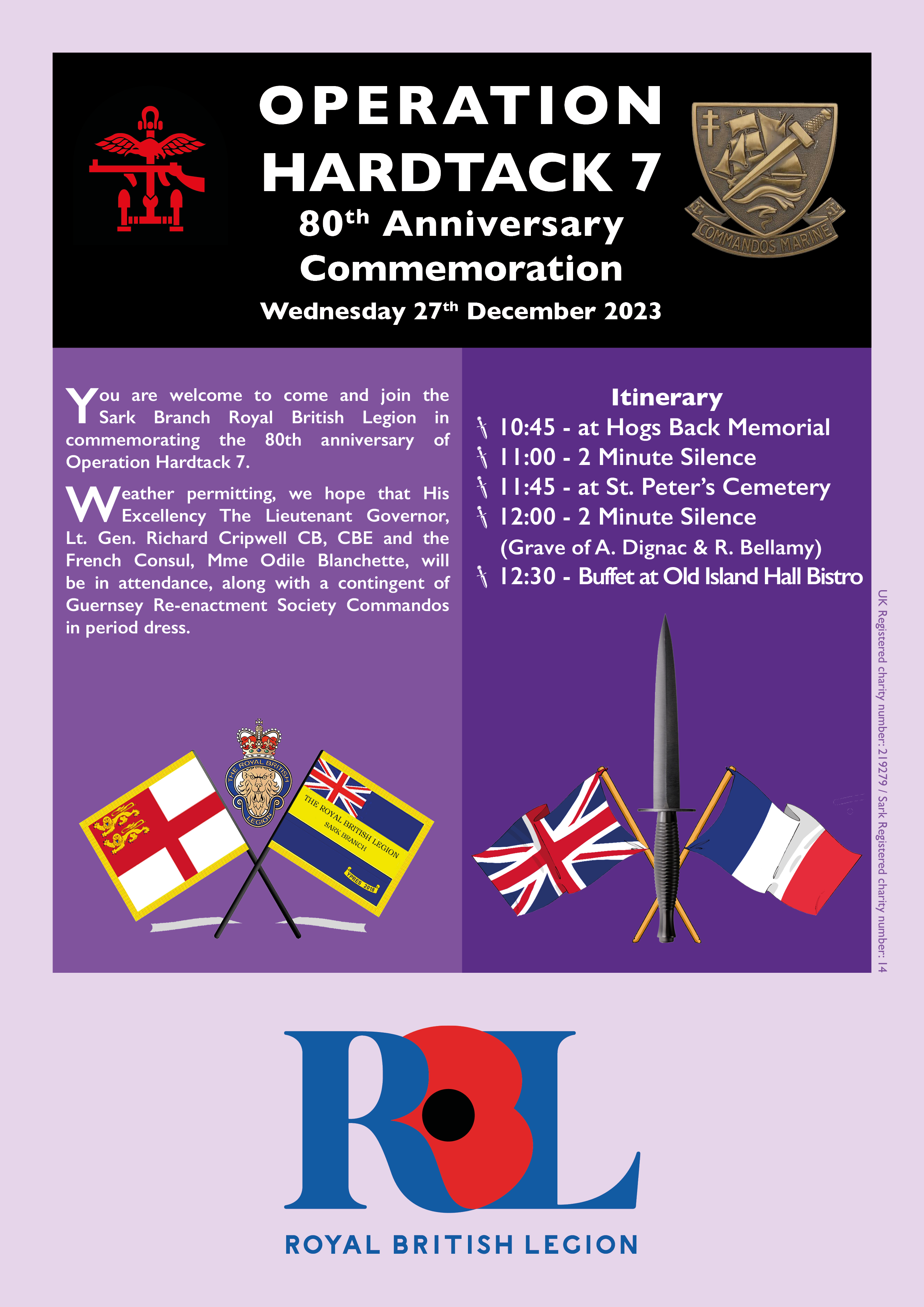
2022

Click on the link for
full pdf document.
2022 80th Anniversary of Op Basalt
Summary- For Legion Magazine[20650].pdf
OPERATION BASALT -
SARK 3RD OCTOBER
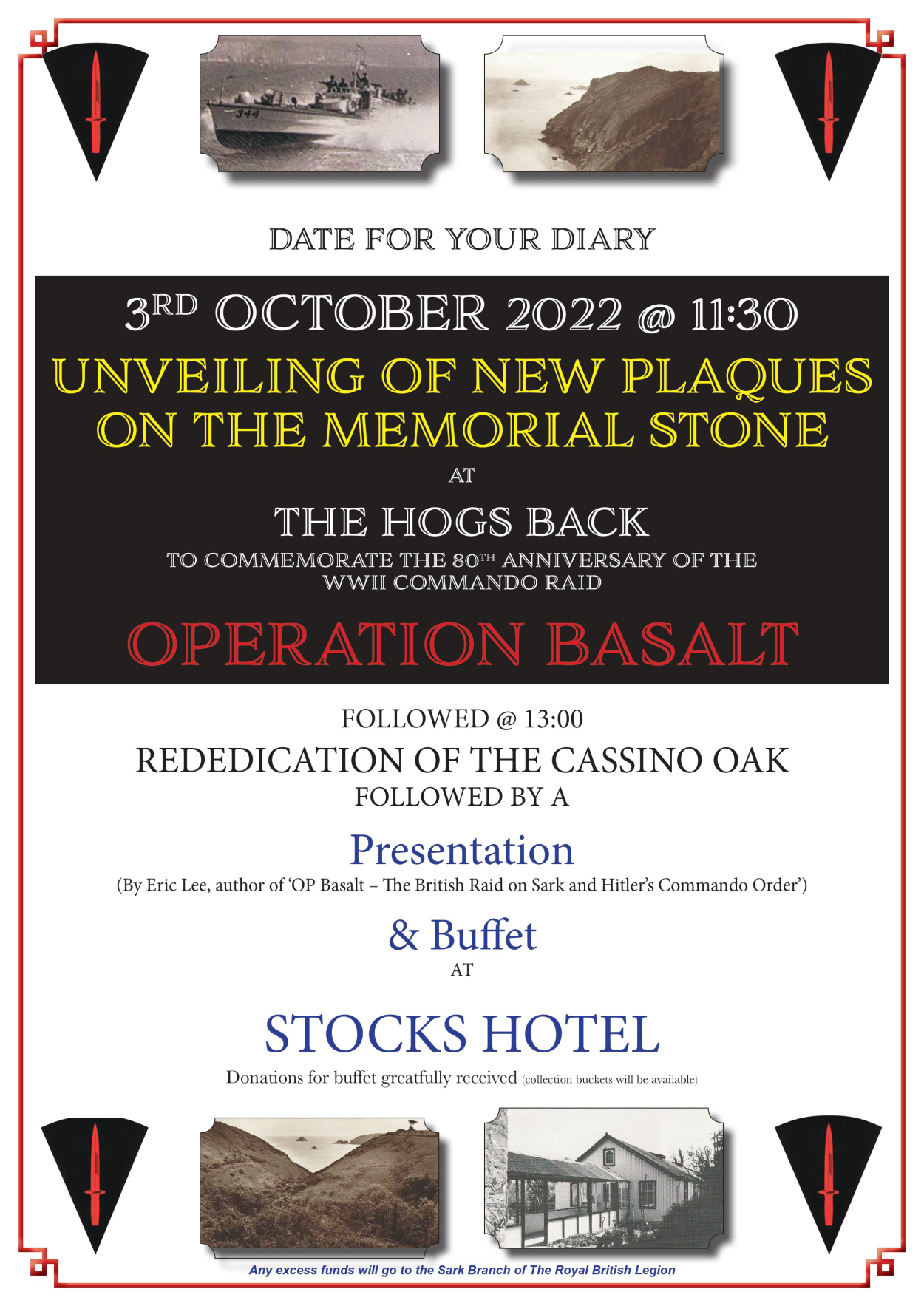
Operation Basalt
Detailed Programme Monday
3rd October 2022
10.00 Ferry departs Guernsey. (There is an 8am sailing also.)
11.30 Hog’s Back –
Welcome by Lt Col Reg Guille MBE (late Army Commando), Chairman of the
Sark Branch, Royal British Legion.
Unveiling of the updated plaques on the Commemorative Stone by Mr Simon
Wood (a cousin of Geoffrey Appleyard) and Captain Karsten Adrian of the
Bundeswehr, a German Officer serving in the Allied Rapid Reaction Corps (ARRC).
The Standard of the Sark Branch, Royal British Legion will be paraded by
Mr John Hunt during the unveiling ceremony.
13.00 Rededication of the Cassio Oak, in its new and more sheltered
location
13.30 – Stocks Hotel, Brasserie
A
short talk, on the selection of the final two names added to the list of
Commandos that took part in the raid, by Mr Eric Lee (Author of the book
Operation Basalt – The British Raid on Sark and Hitler’s Commando Order).
This is an open event and donations are requested to defray the cost of
the buffet, donations go to the Sark Branch of the Royal British Legion.
16.00 – Ferry departs Sark.
For more
information please contact
Lt Col (Retired) RJ Guille,
MBE at
Sark.Chairman@rbl.community
PLUTO (PIPELINE UNDER
THE OCEAN) - ISLE OF WIGHT
ROYAL AERONAUTICAL
SOCIETY (ISLE OF WIGHT BRANCH) - 20TH OCTOBER 2022
LECTURE BY TIM WANDER
 The
route that PLUTO took across the Isle of Wight
started at the Thorness beach terminal and a
pumping station at Whippance Farm. Then over
14 miles it stretched across the Island,
looping around Parkhurst Forest and Newport to
eventually arrive at a huge storage tank
hidden in Hungerberry Wood above Shanklin.
From there pipes fed two pumping stations, one
housed around a derelict hotel in Shanklin,
the other in a part demolished Victorian fort
and a golf clubhouse at Sandown. From there,
72 miles away in Europe, the Allied forces
desperately needed fuel. The
route that PLUTO took across the Isle of Wight
started at the Thorness beach terminal and a
pumping station at Whippance Farm. Then over
14 miles it stretched across the Island,
looping around Parkhurst Forest and Newport to
eventually arrive at a huge storage tank
hidden in Hungerberry Wood above Shanklin.
From there pipes fed two pumping stations, one
housed around a derelict hotel in Shanklin,
the other in a part demolished Victorian fort
and a golf clubhouse at Sandown. From there,
72 miles away in Europe, the Allied forces
desperately needed fuel.
Today, 75 years on, the route of the pipeline
and the buildings associated with PLUTO have
all but disappeared. But if you look closely,
there still are tantalising clues spread
across the Island. I thoroughly enjoy walking
for its own sake, but it is sometimes nice to
have a purpose, if not an excuse. So this book
offers the reader 25 guided walks and detailed
maps to find what still survives of the great
pipeline and the pumping stations; and in
doing so to plot its course. Wherever PLUTO
crossed the path there was usually a unique
marker. They are still out there, waiting to
be discovered.
The whole PLUTO project was massive
undertaking. It was rapid, rushed and at times
improvised. It was also at the very cutting
edge of what was possible. It was always Top
Secret.
In the end, PLUTO under the ocean was not the
success that saved the Allied invasion, and in
truth, it was probably a 'pipeline too far'.
Immediately after the war a propaganda
campaign actively sought to justify the huge
expenditure of man hours and resources just
before the invasion and D-Day.
In fact it now
seems that PLUTO from the Isle of Wight
could never have worked….or not how it was
first intended – to provide pipelines
across the ocean. The real
story is far more interesting and turns the
established history of the Second World War
and D-Day on its head.
But none of this should detract from our
admiration for the magnificent operation and
the men and women who gave their all to make
it happen. It came tantalizingly close to
fully supporting the Allies victory, but was
ultimately beaten by the vagaries of war.
This then is the real story of PLUTO on the
Isle of Wight. A Ramble with a Purpose.
Full account of of the wider PLUTO project
here.
2021
Witness historic moment as
British Normandy Memorial officially opens on 6 June 21


D-Day 77: The Official Opening Of The
British Normandy Memorial
Veterans and relatives of the
Normandy fallen are invited to witness a long-awaited historic moment as
the British Normandy Memorial is officially opened on 6 June 2021, the
77th anniversary of D-Day.
As Covid-19 restrictions prevent
travel to Normandy, the Normandy Memorial Trust and the Royal British
Legion are together hosting a commemorative event at the
National Memorial Arboretum in Staffordshire. Guests will watch a
live broadcast of the official opening of the newly
completed British Normandy Memorial in Ver-sur-Mer, presided over by the
British Ambassador to France, Lord Edward Llewellyn, accompanied by senior
French guests. Normandy Veterans and relatives of the fallen may apply for
a place
here. The
general public will be able to follow the entire event live via the
British Normandy Memorial website.
The commemorations at The Arboretum
will also include coverage of the service of Remembrance at The Bayeux
Commonwealth War Graves Cemetery and a Two Minute Silence at 11am.
The official opening is the culmination of nearly six years of work by the
Normandy Memorial Trust. The idea for the Memorial originated with the
Trust’s Normandy Veteran Patron, George Batts MBE, Leg d’Hon and was taken
up by many other Veterans, including the Trust’s Veteran Ambassador and
Fundraiser, Harry Billinge, MBE, Leg d’Hon.
The Memorial features the ‘D-Day Sculpture’ by British sculptor David
Williams-Ellis, the D-Day Wall featuring the names of those who fell on
D-Day itself and, on 160 stone columns, the names of those others who lost
their lives between D-Day and the Liberation of Paris at the end of August
1944. The site also includes a French Memorial, dedicated to the memory of
French civilians who died during this time.
2020 - NO REPORTED
EVENTS DUE TO COVID 19 VIRUS
2019
75th ANNIVERSARY YEAR OF D-DAY
NATIONAL MEMORIAL
ARBORETUM
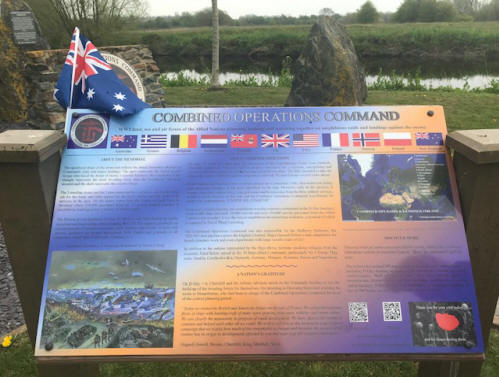 75th
Anniversary of D-Day 75th
Anniversary of D-Day
The National Memorial Arboretum will be holding a
special remembrance service on June 6th at 10.15 am for 10.30
am. There will be a wreath laying ceremony in Heroes Square but
if you wish to lay a wreath or other tribute at the Combined
Operations Command Memorial after the event, or at any other
time, you’re very welcome to do so.
The Australian flag
recently added to the memorial's information display reminds us
that this day will be remembered around the world.
75th Anniversary of D-Day
Event at the COPP (Combined Operations
Pilotage Parties) Memorial at Hayling Island.
Everyone is welcome to attend the ceremony – there is a
large public viewing area with a restricted seated area
for invited guests.
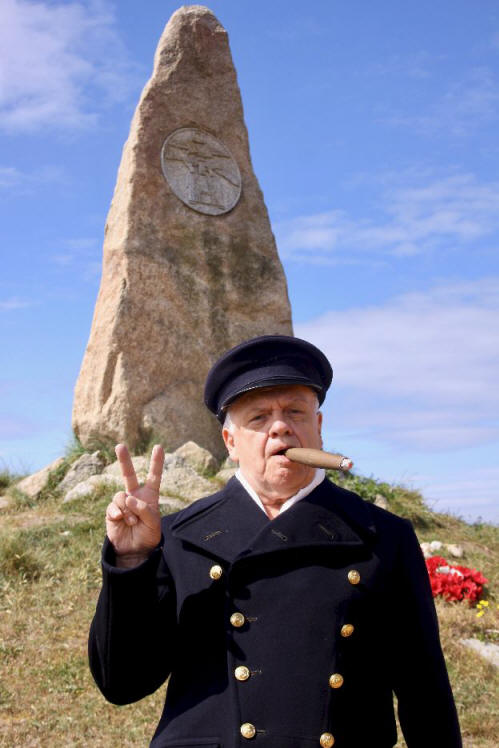 Hi
Geoff, Your website helped gather contacts in the early
days of our appeal and I'd be grateful if you could add
this information to your website. Hi
Geoff, Your website helped gather contacts in the early
days of our appeal and I'd be grateful if you could add
this information to your website.
The Duke of Gloucester is coming to the COPP Memorial for
a D-Day 75th Anniversary event on Thursday, June 6.
Several senior Navy, Army and Royal Marine officers
representing the services who made up COPP, will attend.
HIADS (Hayling Island Amateur Dramatic
Society) actor Laurie Noble will play Winston Churchill,
who will tell the crowd about Hayling’s role in Operation
Overlord – not just the COPPists – but the Landing Caft
crews who were trained at HMS Northney and Operatiion
Fabius II, the dress rehearsal in early May 1944, which
the British Prime Minister and General Eisenhower
travelled to Hayling from Southwick House to watch.
After a musical performance by a choir made
up of schoolchildren from the Island, there will be a
service of remembrance led by Rev Richard Elligham RN.
A Royal Marines bugler will sound The
Last Post followed by a minute’s silence before wreaths
will be laid in memory of all of Hayling’s serviceman
from WWII by the Royal, military and civic guests.
The Hampshire Police Band will play
throughout and the morning will kick-off at 10.30am with a
display by the Fort Cumberland Guard, who will fire a
canon representing the 18th Century artillery
fortification of the Eastney base guarding Langstone
Harbour, which was carried out by the Royal Marines.
SERVICE OF REMEMBRANCE ABOARD D-DAY VETERAN
LANDING BARGE KITCHEN 6 - LBK 6.
News from The Harwich and Dovercourt Sailing
Club. Work is still ongoing on LBK6 to keep her in good
condition, and she will look and be proud on 6th June when
once again we are having a short Service of Remembrance for
all those who took part in the D Day landings. We are lucky to
have a very active Royal British Legion to help us on this
memorable day.
Harwich and Dovercourt Sailing Club warmly
invites any veterans of any service, and any sphere of duty in
the area who would like to join us, to come to the Club and
partake in the short Service, and enjoy a light lunch on LBK6
afterwards, provided by the Club. Contact constable-m@sky.com
for directions of where to find us.
Read the
LBK 6 story here.
COMMANDO RAIDS ON THE CHANNEL ISLAND OF
SARK
75th Anniversary Commemorative Event - 27th December 2018
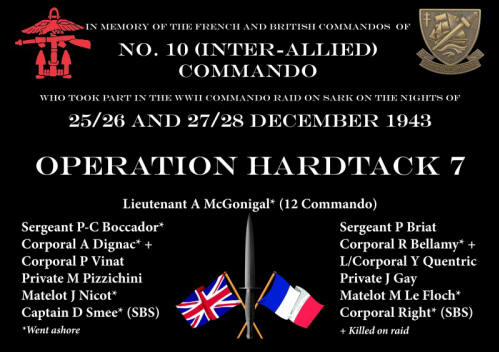 The Sark
Branch of the Royal British Legion are planning to unveil a
commemorative stone on Thursday 27th December (to
accommodate ferries, the original date of the 28th was brought
forward), on the
75th Anniversary of Operation Hardtack 7 on the
island of Sark. The commemorative stone will be unveiled on the
path on the Hog’s Back at the site of the minefield and close to
the spot where the two French Commandos died. It is planned for
this to take place at 12 noon and is to be followed by a lunch
at Stocks Hotel at approximately 1 pm, for those wishing to
attend the commemoration. More details on the programme will be
promulgated when plans are finalised. The Sark
Branch of the Royal British Legion are planning to unveil a
commemorative stone on Thursday 27th December (to
accommodate ferries, the original date of the 28th was brought
forward), on the
75th Anniversary of Operation Hardtack 7 on the
island of Sark. The commemorative stone will be unveiled on the
path on the Hog’s Back at the site of the minefield and close to
the spot where the two French Commandos died. It is planned for
this to take place at 12 noon and is to be followed by a lunch
at Stocks Hotel at approximately 1 pm, for those wishing to
attend the commemoration. More details on the programme will be
promulgated when plans are finalised.
OPERATION HARDTACK 7 - SARK
The Night of the 25th/
26th and 27th/28th December
1943
A
series of Commando Raids were planned under the code name
HARDTACK in late 1943 and were numbered from 1 to 36.
The operations were conducted by men
of
No. 10
(Inter-Allied) Commando,
No. 12
Commando and the
Special
Boat Service (SBS), and took place on the
Channel
islands and the northern coast of
France
in December 1943. Most of the raids consisted of ten men of
various ranks, carried by
Motor
Torpedo/Gun Boats (MTB/MGB) and
dories,
except for one operation, which was an airborne landing. The
raids were ended by order of
Major
General
Robert
Laycock because they caused the enemy to bring up
reinforcements, which could have been detrimental to the
Allies'
strategy for D-Day. In the Channel Islands raids were planned
against Jersey, Herm and Sark. The Herm raid was cancelled in
the planning stage, but the raids on Sark and Jersey went ahead
and both were planned for the night of 25/26 December with the
aims of reconnaissance and capture of prisoners – the Jersey
raid landed safely at Petit Port, climbing the cliff, they
failed to locate a German soldier. On returning to the beach, a
mine was set off seriously injuring a Captain Ayton who was
taken to the beach and returned to England where he died of his
wounds. Like the Jersey raid the Sark raid used men from No. 1
(French) Troop of 10 Commando, 12 Commando and the SBS.
Sark 25/26 December 1943.
Operation Hardtack 7.
The raid on
this night failed to achieve its objectives when the Commandos
were unable to scale the cliff having landed by Dorey from MGB
(ML) 292 on Derrible Point at about 23.15. The Raid was
commanded by an officer from 12 Commando, 10 men from No1 Troop
and 2 men of the SBS, as follows:
Lt Ambrose
McGoniga *12
Commando; Sergeant
Pierre-Charles Boccador * (Translator) 10
Commando; Sergeant Paul
Briat (Radio Operator) 10
Commando; Local
Sergeant Andre Dignac
*10 Commando; Corporal Robert Bellamy * 10 Commando; Corporal
Pierre Vinat (Medical Orderly)10
Commando,
Lance/Corporal Yves Quentric 10 Commando; Private
Marius Pizzichini 10 Commando; Private
Jacques
Gay 10 Commando; Matelot
Joseph Nicot
* 10
Commando; Matelot
Maurice Le Floch * 10 Commando; Captain
David Smee * (Dorey Skipper) SBS; Corporal ? Right * (Dorey
Engineer) SBS
(If anyone knows the name or initials of Cpl Right, please
contact us).
Of the above
men not all went ashore, as the Dorey capacity was 8. Men marked
with * were in the Dorey the remainder stayed on the MGB.
Dignac
(Nicknamed ‘Tarzan’ for his climbing ability) led the climb but
was unable to make the final ascent and at 02.15 gave up the
attempt. Back on the Dorey, McGonigal and Boccador decide to
survey the beach of Derrible Bay and the cliff of the Hog’s
Back, they encountered and brought back a mine. They returned to
the MGB at 04.10 and headed back to Dartmouth. On arrival they
are given permission to try again and planned another raid for
the 27/28 December.
Sark 27/28 December 1943.
Operation Hardtack 7.
MGB (ML) 322
(Took part in the Jersey raid) was their boat for the raid and
left Dartmouth at 16.00. This time the Commandos landed from
Dixcart Bay onto the Hog’s Back at 22.20 and the same men go
ashore again, with Dignac leading the climb and paying out a
rope for the others to use. The rudimentary map they used marked
a minefield and they moved forward carefully but suddenly a mine
exploded and Bellamy is killed almost instantly, the same
explosion also badly wounds Dignac who dies as he is being
injected with morphine by Boccador. More mines are set off as
they escape from the minefield and Le Flock is wounded in the
chest but can walk, as can the wounded Nicot and McGonigal.
Boccador is unwounded and is the one that helps all the others
to the rope and down the cliff. They are on board the Dorey by
02.30 and on the MGB by 03.00 when they set off for Dartmouth,
with Vinat treating the wounded on the journey, on arrival the
wounded are immediately taken to hospital.
The German
report on the raid to Commander Northwest France and made on the
29th December said:
On the
28th between midnight and 2.45 am the raiding patrol against the
Isle of Sark started. The base garrison located in the middle of
the island reported 5 explosions at 1.10 am. At the crack of
dawn 2 soldiers in English uniforms have been found on the
minefield above the steep coast near Dixcart Valley, one was
recognised as French, one was already dead and the other one
moribund. Landing took place at the same spot like in
04/10/1942, supposedly in a small vehicle. Force of command is
unknown. Injuries found originate from small mine pieces.
According to the traces of blood found on coastal rocks more
wounded or dead soldiers are expected. Weapons and armament have
been left behind, among them was a radiotelephone.
Dignac and
Bellamy were buried in the Sark cemetery on the 30th
December. It is said that the Dame of Sark demanded to know the
names of the men for the Death Register of the island.
No. 10 (Inter-Allied) Commando
Troops for
this Commando were made up from various countries and each Troop
in the Commando was formed up of Nationals from each country, as
follows:
No. 1 Troop
(French). No. 2 Troop (Dutch), No. 3 Troop
(British),* No. 4 Troop ((Belgian), No. 5 Troop
(Norwegian), No. 6 Troop (Polish), No. 7 Troop
(Yugoslavian) & No. 8 Troop (French).
* This Troop
was made up of mainly German (Jewish) Nationals that had come to
Britain as refugees from Nazi Germany, but this did not show in
their title. Each man was given a British name and documents to
support that name. Being German speaking, they were often used
behind enemy lines and as interrogators to gain intelligence.
The graves of those killed in action were marked with the normal
cross, but those were later replaced by the Jewish symbol, the
Star of David.
Lt Col Reg
Guille MBE
Chairman
|





 The
route that PLUTO took across the Isle of Wight
started at the Thorness beach terminal and a
pumping station at Whippance Farm. Then over
14 miles it stretched across the Island,
looping around Parkhurst Forest and Newport to
eventually arrive at a huge storage tank
hidden in Hungerberry Wood above Shanklin.
From there pipes fed two pumping stations, one
housed around a derelict hotel in Shanklin,
the other in a part demolished Victorian fort
and a golf clubhouse at Sandown. From there,
72 miles away in Europe, the Allied forces
desperately needed fuel.
The
route that PLUTO took across the Isle of Wight
started at the Thorness beach terminal and a
pumping station at Whippance Farm. Then over
14 miles it stretched across the Island,
looping around Parkhurst Forest and Newport to
eventually arrive at a huge storage tank
hidden in Hungerberry Wood above Shanklin.
From there pipes fed two pumping stations, one
housed around a derelict hotel in Shanklin,
the other in a part demolished Victorian fort
and a golf clubhouse at Sandown. From there,
72 miles away in Europe, the Allied forces
desperately needed fuel.





